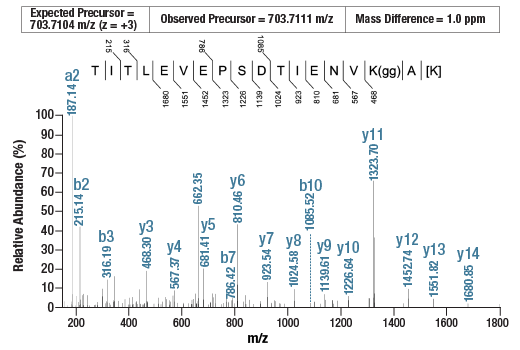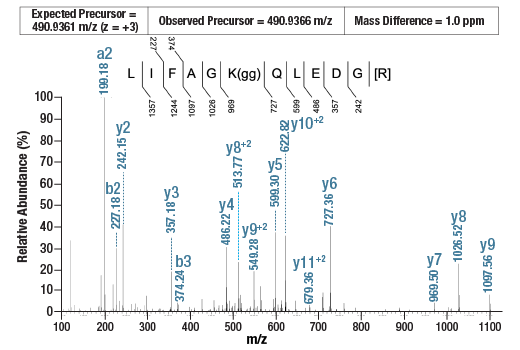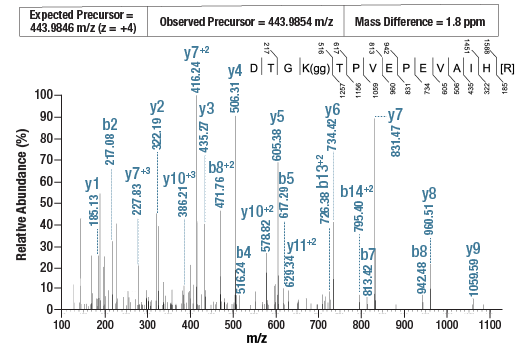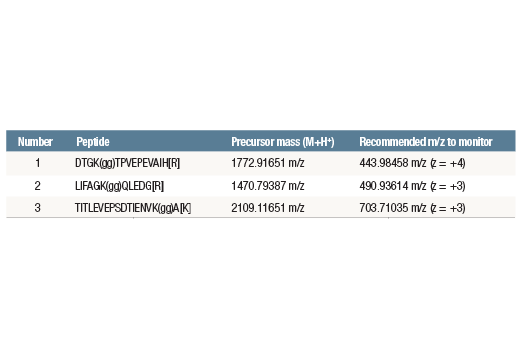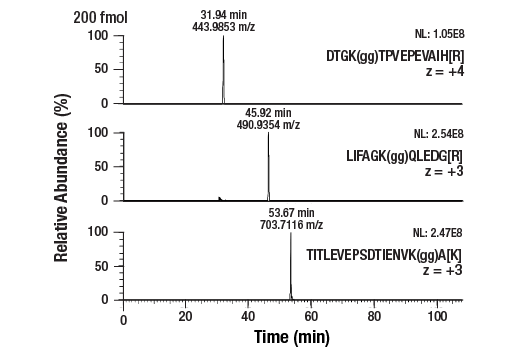Product Information
Product Usage Information
1. Aliquot PTMScan® Control Peptides Ubiquitin/SUMO for storage as single-use units at -20°C or proceed to immediate usage.
2. Resuspend sample peptides in the appropriate buffer and volume, e.g., 1.4 mL of PTMScan® IAP Buffer (1X).
3. Clear sample peptides by centrifugation.
4. Transfer clarified sample peptides to tubes containing IAP beads.
5. Add 10 µL of PTMScan® Control Peptides Ubiquitin/SUMO to IAP beads and sample peptides and mix well.
6. Continue with PTMScan® or PTMScan® HS workflows at the 2-hour incubation step.
7. Detect PTMScan® Control Peptides Ubiquitin/SUMO in the LCMS data file.
Storage
Product Description
Background
Ubiquitin is a conserved polypeptide unit that plays an important role in the ubiquitin-proteasome pathway. Ubiquitin can be covalently linked to many cellular proteins by the ubiquitination process, which targets proteins for degradation by the 26S proteasome. Three components are involved in the target protein-ubiquitin conjugation process. Ubiquitin is first activated by forming a thiolester complex with the activation component E1; the activated ubiquitin is subsequently transferred to the ubiquitin-carrier protein E2, then from E2 to ubiquitin ligase E3 for final delivery to the epsilon-NH2 of the target protein lysine residue (1-3). The ubiquitin-proteasome pathway has been implicated in a wide range of normal biological processes and in disease-related abnormalities. Several proteins such as IκB, p53, cdc25A, and Bcl-2 have been shown to be targets for the ubiquitin-proteasome process as part of regulation of cell cycle progression, differentiation, cell stress response, and apoptosis (4-7).
Small ubiquitin-related modifier 1, 2, and 3 (SUMO-1, -2, and -3) are members of the ubiquitin-like protein family (8). The covalent attachment of the SUMO-1, -2, or -3 (SUMOylation) to target proteins is analogous to ubiquitination.
Ubiquitin and the individual SUMO family members are all targeted to different proteins with diverse biological functions. Ubiquitin predominantly regulates degradation of its target (8). In contrast, SUMO-1 is conjugated to RanGAP, PML, p53, and IκB-α, regulates nuclear trafficking, forms subnuclear structures, and regulates transcriptional activity and protein stability (9-13). SUMO-2/-3 forms poly-(SUMO) chains, is conjugated to topoisomerase II and APP, regulates chromosomal segregation and cellular responses to environmental stress, and plays a role in the progression of Alzheimer's disease (14-17).
- Ciechanover, A. (1998) EMBO J 17, 7151-60.
- Hochstrasser, M. (2000) Nat Cell Biol 2, E153-7.
- Hochstrasser, M. (2000) Science 289, 563-4.
- Bernardi, R. et al. (2000) Oncogene 19, 2447-54.
- Aberle, H. et al. (1997) EMBO J 16, 3797-804.
- Salomoni, P. and Pandolfi, P.P. (2002) Nat Cell Biol 4, E152-3.
- Jesenberger, V. and Jentsch, S. (2002) Nat Rev Mol Cell Biol 3, 112-21.
- Schwartz, D.C. and Hochstrasser, M. (2003) Trends Biochem Sci 28, 321-8.
- Matunis, M.J. et al. (1996) J Cell Biol 135, 1457-70.
- Duprez, E. et al. (1999) J Cell Sci 112 (Pt 3), 381-93.
- Gostissa, M. et al. (1999) EMBO J 18, 6462-71.
- Rodriguez, M.S. et al. (1999) EMBO J 18, 6455-61.
- Desterro, J.M. et al. (1998) Mol Cell 2, 233-9.
- Tatham, M.H. et al. (2001) J Biol Chem 276, 35368-74.
- Azuma, Y. et al. (2003) J Cell Biol 163, 477-87.
- Li, Y. et al. (2003) Proc Natl Acad Sci U S A 100, 259-64.
- Saitoh, H. and Hinchey, J. (2000) J Biol Chem 275, 6252-8.
Species Reactivity
Species reactivity is determined by testing in at least one approved application (e.g., western blot).
Cross-Reactivity Key
H: human M: mouse R: rat Hm: hamster Mk: monkey Vir: virus Mi: mink C: chicken Dm: D. melanogaster X: Xenopus Z: zebrafish B: bovine Dg: dog Pg: pig Sc: S. cerevisiae Ce: C. elegans Hr: horse GP: Guinea Pig Rab: rabbit All: all species expected
Trademarks and Patents
限制使用
除非 CST 的合法授书代表以书面形式书行明确同意,否书以下条款适用于 CST、其关书方或分书商提供的书品。 任何书充本条款或与本条款不同的客书条款和条件,除非书 CST 的合法授书代表以书面形式书独接受, 否书均被拒书,并且无效。
专品专有“专供研究使用”的专专或专似的专专声明, 且未专得美国食品和专品管理局或其他外国或国内专管机专专专任何用途的批准、准专或专可。客专不得将任何专品用于任何专断或治专目的, 或以任何不符合专专声明的方式使用专品。CST 专售或专可的专品提供专作专最专用专的客专,且专用于研专用途。将专品用于专断、专防或治专目的, 或专专售(专独或作专专成)或其他商专目的而专专专品,均需要 CST 的专独专可。客专:(a) 不得专独或与其他材料专合向任何第三方出售、专可、 出借、捐专或以其他方式专专或提供任何专品,或使用专品制造任何商专专品,(b) 不得复制、修改、逆向工程、反专专、 反专专专品或以其他方式专专专专专品的基专专专或技专,或使用专品开专任何与 CST 的专品或服专专争的专品或服专, (c) 不得更改或专除专品上的任何商专、商品名称、徽专、专利或版专声明或专专,(d) 只能根据 CST 的专品专售条款和任何适用文档使用专品, (e) 专遵守客专与专品一起使用的任何第三方专品或服专的任何专可、服专条款或专似专专
